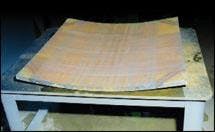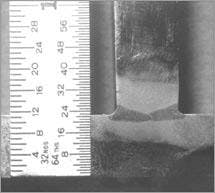By Paul A. Blomquist
Editors Note: When this review of activity in North American shipyards was started we quickly learned that most of the advanced work in large commercial vessel shipbuilding is taking place outside this country. There are exceptions, Bender Shipbuilding and Repair for example, but the truly innovative developments are happening at shipyards located in Europe.
However, as the world's major Naval presence, the U.S. Navy places demands on this nation's shipbuilders to improve design, fabrication and assembly practices. This is done with an eye on costs as the price for fleet modernization reaches astronomical levels.
We asked Paul Blomquist, an engineer with more than twenty years' experience with shipyard operations, to review the current status of laser activity in support of Navy shipbuilding programs. –DAB
Several U.S. shipyards have installed low–power laser cutters, either as standalone units or integrated with turret punch equipment for sheetmetal operations. These have been "commodity–type" purchases in which the equipment has not been particularly innovative for marine applications and, in general, was already in widespread use in other industries before shipyards adopted it.
Bender Shipbuilding and Repair (Mobile, AL) broke new ground with the installation of the first large–scale equipment for cutting ship–size (12 x 50 feet, more than 1–inch thick) plates (see ILS May 2001). Bender subsequently built the first vessel to have its plating fully laser cut–and noted significant reductions in assembly cost and time, as well as savings in welding re–work, all due to the accuracy of laser cutting and the speed with which accurately cut assemblies could be fit and welded together. While improved accuracy has yielded reported productivity gains of 10 percent in Japan (www.onr.navy.mil/onasia), the improvement in U.S. yards is expected to be much higher, perhaps as high as 20–30 percent.
This progress has not gone unnoticed, and in late 2001, a large–scale laser cutting table went on–line at the Quonset Point Rhode Island facility of the General Dynamics Electric Boat (GDEB) Corporation (see ILS February 2002).
Figure 1. Macro–section of laser weld in 0.375–in. carbon steel T–section used in DDG–51 HEPA filter array frame.
Laser welding
At the end of the millennium, only three U.S.–built classes of marine vessels had made use of laser welding for any components. The USS Mount Whitney had laser–welded corrugated core (LASCOR) sandwich panels installed during an alteration. Several DDG–51 Destroyers had laser–welded non–structural components in the ventilation system (see Figure 1). And the Ingalls Shipbuilding (now Northrop Grumman Ship Systems Ingalls Operations–NGSS/IO) built SAAR–5 corvettes, for the Israeli navy, using laser welded high–strength, low–alloy steel T–sections. While all of these applications were successful, none had a high enough volume to generate the level of business and economies of scale necessary for sustained production. Furthermore, the stringent qualification requirements invoked by the Navy for "new" welding processes remained a major obstacle to even the consideration of laser welding as a significant process by U.S. shipbuilders. Fortunately, that situation is changing, with investment by the Navy aimed at establishing a clear set of procedure qualification requirements and acceptance criteria for laser welding.
The Office of Naval Research (ONR) through various programs such as the Manufacturing Tech nology (MANTECH) program, the National Ship building Research Pro gram (NSRP) and Small Business Innovative Research (SBIR) programs has funded several initiatives aimed at the implementation of laser welding technology into U.S. shipbuilding. Edison Welding Institute (EWI–Columbus, OH) has been developing laser/MIG "hybrid" welding techniques with shipbuilding steels; the Applied Research Laboratory at Penn State University (ARL–State College, PA) has partnered in these efforts as well as on work performed at Lehigh University (Bethlehem, PA) on a newer corrosion–resistant alloy, AL6XN.
In addition to these efforts, a major project was initiated in late 2001 aimed at qualifying the laser welding process for the production of structural shapes to be used in stiffening the deck, shell and bulkhead panels of U.S. Navy combatant ships. This project, titled "Laser Fabricated Structural Shapes for Naval Applications" (LFSS/N), is a team effort, led by Technology Systems Inc. (Wiscasset, ME) and including Applied Thermal Sciences (Sanford, ME), ARL, EWI, Caterpillar, Bender, Newport News Shipbuilding, the American Bureau of Shipping, the Naval Surface Warfare Center at Carderock and others.
A critical part of the program is the development of a comprehensive adaptive control system for the laser welding process, to allow a high degree of automation. Sensors will feed pre–process, in–process and post–process information to the control system. In addition to process control, the system will provide real–time output as to product quality, and that information will be used as documentation to certify compliance to manufacturing specifications. Automation of these functions can save nearly 30 percent of the costs of manufacturing T–shapes. Additionally, overhead inventory and scrap costs can be slashed. Shipyards now must maintain a catalog of more than 150 different items to provide all the hot–rolled T–shapes needed to build a destroyer. By laser cutting web and flange pieces from plate and laser welding them into the needed shapes, this catalog can be reduced to only twelve plate items.
The LFSS/N program will develop de sign rules for structural shapes, perform the necessary tests to validate the strength and fatigue performance of laser–welded products, and generate needed parameters for the high–volume production of these structural shapes. One implementation target is the nation's newest aircraft carrier (CVN–78), which will make extensive use of structural T–shapes fabricated of high–strength, low–alloy steel having a yield strength of 65 ksi. Be tween the higher strength of the steel, and the opportunity to create sections having a better structural efficiency, nearly 200 tons of weight can be saved on this vessel.
Laser–assisted plate forming
The outer hull plating of Naval combatants is constructed of moderately thick steel plating. Regions of this plating are designed with complex three–dimensional curvatures to satisfy hydrodynamic and signature requirements. Cur rent thermo–mechanical plate forming practices involve manual line heating or arduous furnace and press operations to create the required contours. These labor–intensive tasks are difficult, dangerous and give unpredictable results. Significant cost savings are anticipated by automating this process. The energy gradients and the inherent controllability make laser methods of immediate interest.
In 1995, DARPA funded a team consisting of Rocketdyne, Boeing, MIT, ARL Penn State and Newport News to investigate the ability of high–power lasers to form complex curves in thick plate. The success of this program led to a 1997 Mantech Rapid Response Project in which ARL Penn State collaborated with NGSS /IO to demonstrate the laser forming process on a portion of an actual hull component to de velop cost metrics. In 2000, ARL Penn State worked with NGSS/ IO to win a competitive Maritech ASE program to further advance this promising technology by developing a prototype system with fully automated path planning capability.
Figure 2. Laser–formed heavy plate section duplicates the improved curvature of a ship hull.
In 2001, the ARL/NGSS effort was coupled with a project exploring conventional heating (EWI and Bath Iron Works), and placed under the management of the National Center for Excellence in Metalworking Tech nology (NCEMT). To date, ARL Penn State has been successful in demonstrating a fully integrated lab prototype (see Figure 2), and has embarked on a plan to develop the automated process planning technology necessary to make shipyard implementation a reality.
The future
Laser technology has revolutionized manufacturing in a wide variety of US industries. Now in shipbuilding, progress is being made in the cutting, welding and forming of plates. Potential areas may include cutting and welding of piping systems, surface modification (preparation, marking and cladding) and manufacture of net–shape components by powder consolidation.
American shipyards have been accused of being slow to adopt advanced technology, but often there are roadblocks in the form of government approval of new methods. Today, the Navy and U.S. yards together are investing in laser technology to propel shipbuilding into a more productive future.
The International Scene
The use of lasers in international shipbuilding operations has gained greater acceptance than in the United States. Some of this is due to the larger number of commercial shipyards located outside the U.S. and the non–competitiveness of U.S. shipyards competing for contracts to build large commercial vessels, such as cruise ships.
In Japan, high–power laser plate cutting systems have been installed in the shipyards of Kawasaki, Mitsui, Minami Nippon, Hakata, Sumitomo, Hitachi and others. Laser welding has received limited acceptance, with Kawasaki Heavy Industries taking a leadership position in thick–plate welding technology.
In Europe, Fincantieri (Treiste) has been welding non–structural panels since 1996 (see ILS January 1997). In Germany, MeyerWerft (Papenburg) started welding sandwich composites in 1995 (see ILS June 1995). Today the company markets this product, I–core, which is produced on a new 6kW CO2 laser system. A major installation of four 12kW CO2 lasers is just being commissioned at Meyer. These are arranged on large gantries to weld thick–plate stiffeners of varying lengths, using a hybrid laser/MIG process. ILS will profile this laser application in a subsequent issue.
Odense Steel Shipyard (Den mark) uses a 15kW CO2 laser on a five–axis gantry to weld structural plate. In addition, Blohm + Voss (Ham burg) recently installed a large gantry system, powered by a 12kW CO2 laser, to weld hull stiffeners. –DAB
Paul A. Blomquist is manager, Maritime Tech nology Pro grams, Laser Process Division, Applied Research Lab Penn State University. Contact him at [email protected].

